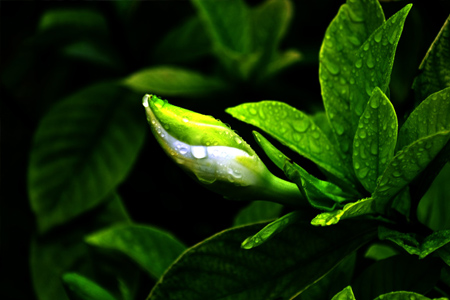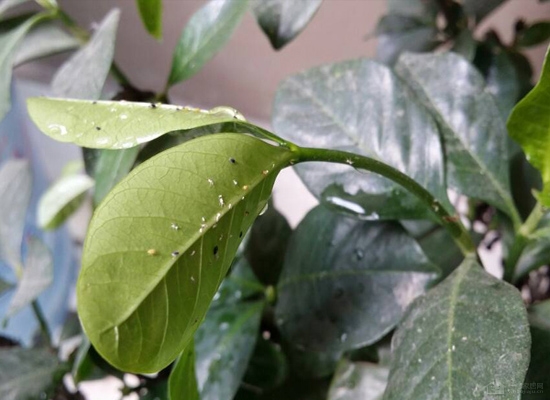Prevention and control of gardenia anthracnose: how to treat gardenia anthracnose? what drugs are used for gardenia anthracnose?
[symptoms] the disease mainly damages the leaves of Gardenia jasminoides. From the leaf tip, leaf edge began to occur, the formation of irregular or nearly round brown spots. Sometimes the whole leaf turns brown, causing the branch to wither or the whole plant to die. Most of the diseases occurred from the lower leaves of the plant. Under moist conditions, there were small black spots on both sides of the leaf, and most of them were on the back of the leaf (conidium on the leaf surface and ascomycete on the back of the leaf).
[pathogen] the pathogen is Colletotrichum gloeosporioides, which belongs to the subphylum of half-known bacteria. Conidia Terete, colorless, unicellular. The conidium disk was initially buried under the host epidermis and then broke through the epidermis exposure. Setae dark brown, straight or slightly curved, 1-2-spaced. Conidiophores cylindrical, colorless, 10~20um × 1.5~2.5um in size. Conidia cylindric, slightly curved, colorless, unicellular, 12~20um × 4~7um in size, often with 1 or 2 oil globules.
[occurrence regularity] overwintering with mycelium lurking on diseased leaves. When the temperature and humidity were suitable in the spring of the following year, conidia were produced for infection. The characteristic of the pathogen is that a large number of phenotypes, namely ascomycetes, can also be formed in the growing season. The conditions of high temperature and high humidity are beneficial to the disease. The seedlings of Gardenia jasminoides were transported on the way, and the incidence was high in the hot and humid environment with poor ventilation.
[prevention and control methods] ① agricultural control. Timely removal of diseased fallen leaves and centralized destruction to reduce the source of infection. Scientific management of water and fertilizer, appropriate application of organic fertilizer, phosphorus and potassium fertilizer to avoid excessive nitrogen fertilizer. When watering, try to do it in the morning and water thoroughly once. Chemical control of ②. Spray 1% Bordeaux solution before the disease to prevent and protect the plant. During the onset of the disease, 50% Shibao Gong 1000 times liquid or 10% world high 1000 times liquid, 430g/L can be sprayed. Haolik 2500 times liquid, 75% chlorothalonil wettable powder 500 times 800 times liquid, etc.
Control methods of anthracnose of Gardenia jasminoides
Symptom
The disease mainly damages the leaves of Gardenia jasminoides. Most of the diseases began from the lower leaves of the plant, and brown round spots were formed on the infected leaves, and the whole leaves gradually turned yellow and fell off. The disease can also occur from the tip and edge of the leaf, forming irregular brown disease spots, and the whole leaf gradually turns brown, hard and shedding. Plants with serious diseases can shed a large number of leaves and lead to branches and even die. Under wet conditions, there are small black spots on both sides of the leaf, and most of them are small black spots on the back of the leaf (conidium on the leaf surface and ascomycete on the back of the leaf).
Pathogen and current situation of disease
The disease is a fungal disease, which is caused by the infection of Chaetomium pericardium. The pathogen overwintered mainly by mycelium, and the conidia were formed when the temperature and humidity were suitable in the spring of the following year. The characteristic of this bacteria is that a large number of phenotypes, namely ascomycetes, can also be formed in the growing season. The condition of high temperature and high humidity is beneficial to the disease. It occurred in Beijing from April to October. The seedlings of Gardenia jasminoides are on the way, with poor ventilation and hot and humid environment, and the incidence is high.
Prevention and cure method
1. Remove the fallen leaves in time and destroy them centrally to reduce the source of infection.
2. Chemical control. 1% Bordeaux solution is sprayed before the disease to protect the plant from infection; 75% chlorothalonil wettable powder 500Mel 800 times can be sprayed during the disease.
3. At the initial stage of the disease, the rhizosphere soil can be irrigated with ferrous sulfate (black alum) 30 / 50 times, or mixed retting with "alum fertilizer water" (2.5 kg of ferrous sulfate, 5 kg of bean cake and 15 kg of pig manure, which was fermented and ripened for 15 days) and watered at intervals with clear water. The leaf surface can also be sprayed with 0.1% Mel 0.2% ferrous sulfate solution.
Anthracnose of gardenia flower
1. Symptoms:
The disease mainly damages the leaves of Gardenia jasminoides. Most of the diseases began from the lower leaves of the plant, and brown round spots were formed on the infected leaves, and the whole leaves gradually turned yellow and fell off. The disease can also occur from the tip and edge of the leaf, forming irregular brown disease spots, and the whole leaf gradually turns brown, hard and shedding. Plants with serious diseases can shed a large number of leaves and lead to branches and even die. Under wet conditions, there are small black spots on both sides of the leaf, and most of them are small black spots on the back of the leaf (conidium on the leaf surface and ascomycete on the back of the leaf).
2. Pathogen and morbidity status:
The disease is a fungal disease, which is caused by the infection of Chaetomium pericardium. The pathogen overwintered mainly by mycelium, and the conidia were formed when the temperature and humidity were suitable in the spring of the following year. The characteristic of this bacteria is that a large number of phenotypes, namely ascomycetes, can also be formed in the growing season. The condition of high temperature and high humidity is beneficial to the disease. It occurred in Beijing from April to October. The seedlings of Gardenia jasminoides are on the way, with poor ventilation and hot and humid environment, and the incidence is high.
Prevention and control methods:
1. Remove the fallen leaves in time and destroy them centrally to reduce the source of infection.
2. Chemical control. 1% Bordeaux solution is sprayed before the disease to protect the plant from infection; 75% chlorothalonil wettable powder 500Mel 800 times can be sprayed during the disease.
3. At the initial stage of the disease, the rhizosphere soil can be irrigated with ferrous sulfate (black alum) 30 / 50 times, or mixed retting with "alum fertilizer water" (2.5 kg of ferrous sulfate, 5 kg of bean cake and 15 kg of pig manure, which is applied after 15 days of fermentation and ripening) and watered at intervals with clear water. The leaf surface can also be sprayed with 0.1% Mel 0.2% ferrous sulfate solution.
- Prev

Why do gardenia leaves turn yellow?
There are many reasons for the yellowing of gardenia leaves, and the common one is caused by "chlorosis" caused by physiological diseases. Whether potted or cultivated in the ground, if the soil is alkaline or iron deficient, it is more common. Iron deficiency is characterized by the loss of green and yellowing between the veins of young leaves, and seriously yellowing the leaves of the whole plant.
- Next

What are the main diseases and insect pests of gardenia? How to prevent and cure?
There are not many diseases and insect pests in gardenia, mainly scale insects, bituminous coal disease and rot. The prevention and control methods are as follows: (1) Bituminous coal disease is scrubbed with clean water, or sprayed with Baume 0.3% stone sulfur mixture, or carbendazim 1000-1200 times liquid. (2) scrape off the rotten parts in time.
Related
- Fuxing push coffee new agricultural production and marketing class: lack of small-scale processing plants
- Jujube rice field leisure farm deep ploughing Yilan for five years to create a space for organic food and play
- Nongyu Farm-A trial of organic papaya for brave women with advanced technology
- Four points for attention in the prevention and control of diseases and insect pests of edible fungi
- How to add nutrient solution to Edible Fungi
- Is there any good way to control edible fungus mites?
- Open Inoculation Technology of Edible Fungi
- Is there any clever way to use fertilizer for edible fungus in winter?
- What agents are used to kill the pathogens of edible fungi in the mushroom shed?
- Rapid drying of Edible Fungi

